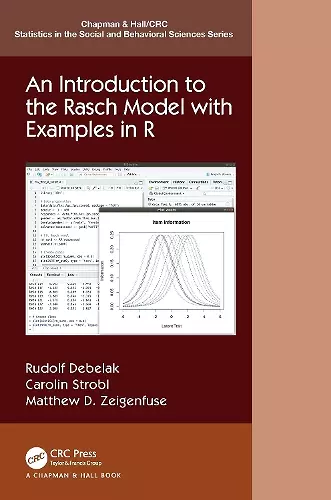An Introduction to the Rasch Model with Examples in R
Rudolf Debelak author Carolin Strobl author Matthew D Zeigenfuse author
Format:Paperback
Publisher:Taylor & Francis Ltd
Published:7th Jun '22
Currently unavailable, and unfortunately no date known when it will be back
This paperback is available in another edition too:
- Hardback£160.00(9781032265582)

An Introduction to the Rasch Model with Examples in R offers a clear, comprehensive introduction to the Rasch model along with practical examples in the free, open-source software R.
It is accessible for readers without a background in psychometrics or statistics, while also providing detailed explanations of the relevant mathematical and statistical concepts for readers who want to gain a deeper understanding. Its worked examples in R demonstrate how to apply the methods to real-world examples and how to interpret the resulting output.
In addition to motivating and presenting the Rasch model, the book covers different methods for parameter estimation and for assessing fit and differential item functioning (DIF). While focusing on the Rasch model, it also addresses a variety of other dichotomous and polytomous Rasch and item response theory (IRT) models, such as two-parameter logistic (2PL) and Partial Credit models, and extensions, including mixture Rasch models and computerized adaptive testing (CAT).
Theory is presented in a self-contained way. All necessary mathematical and statistical background is contained in the chapters and appendices. The book also provides detailed, step-by-step instructions for getting started with R and using the eRm, mirt, TAM and rstan packages for fitting Rasch models.
“Overall, the book has a lot of great detail and is technically sound. It is also clearly written and at an appropriate level of difficulty. Another big strength is the chapters with R applications. I know my students would love this, and generally this is the type of guidance they want with respect to conducting IRT in R, as opposed to trying to field through the different packages, figure out how they scale latent variables in the package, and more. A final big strength is the focus on fairness as a core underlying issue of model evaluation. From the Introduction chapter and throughout the various other chapters, issues of fairness were put at the forefront. This aligns with the Standards for Educational and Psychological Testing, and in general with modern views of validity and test theory.”
- Anne Corinne Huggins-Manley. University of Florida
“With regard to R, I think it provides a good introduction. The book explains the basic features of R code and then proceeds to give many examples of R “in action”, which I think it a good approach. Overall, the book is very well-written. Most of the explanations of Rasch model properties or R commands are extraordinary clear.”
- Leah Feuerstahler, Fordham University
“Overall, the book has a lot of great detail and is technically sound. It is also clearly written and at an appropriate level of difficulty. Another big strength is the chapters with R applications. I know my students would love this, and generally this is the type of guidance they want with respect to conducting IRT in R, as opposed to trying to field through the different packages, figure out how they scale latent variables in the package, and more. A final big strength is the focus on fairness as a core underlying issue of model evaluation. From the Introduction chapter and throughout the various other chapters, issues of fairness were put at the forefront. This aligns with the Standards for Educational and Psychological Testing, and in general with modern views of validity and test theory.”
- Anne Corinne Huggins-Manley, University of Florida, USA
“With regard to R, I think it provides a good introduction. The book explains the basic features of R code and then proceeds to give many examples of R “in action”, which I think it a good approach. Overall, the book is very well-written. Most of the explanations of Rasch model properties or R commands are extraordinary clear.”
- Leah Feuerstahler, Fordham University, USA
"The book “An Introduction to the Rasch Model with Examples in R” provides a comprehensive compendium of the Rasch model as a cornerstone of psychometric measurement. The authors offer a well-written introduction into the basic concepts of the Rasch model for binary items, with a particular focus on differential item functioning and on fit statistics for model evaluation and item selection. Hands-on examples illustrate the use of R syntax for various packages and demonstrate the interpretation of results for real-life research questions. Moreover, the book contains an up-to-date overview of model extensions to accommodate ordinal response formats and parameter heterogeneity. Throughout the book, the content is accessible to the reader without sacrificing mathematical and statistical rigor. The book therefore proves to be a valuable source for different audiences, including students in introductory or advanced classes on test theory, instructors and interested scholars, as well as applied psychometricians. With its combination of statistical detail and applied perspective, the book will certainly help to pave the way for modern item response theory to be used in practice and to overcome the shortcomings of classical test theory."
-Thorsten Meiser, University of Mannheim, Germany
ISBN: 9781138710467
Dimensions: unknown
Weight: 453g
306 pages